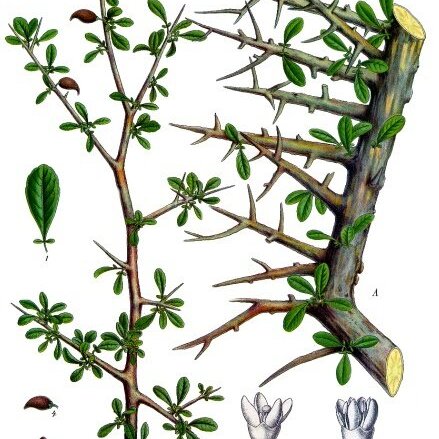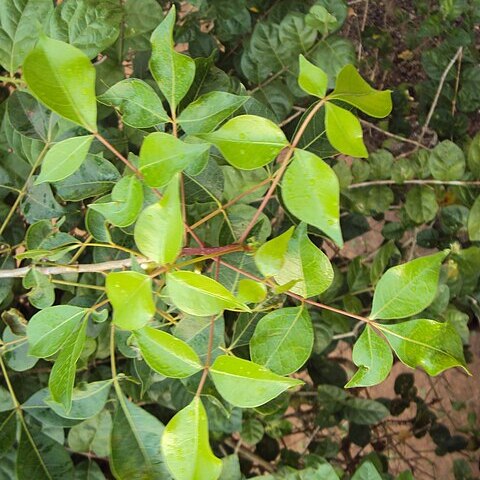Small or medium-sized trees or shrubs, usually imperfectly dioecious, rarely monoecious. Outer bark of trunk and large branches usually translucent and peeling away from the green under-bark.. Exudate a gummy resin or liquid and volatile, often aromatic, the exudate may be copious, scanty or hardly apparent; it is not clear whether this is a genetically based character, more or less constant for each taxon or dependent on edaphic or seasonal factors.. Wood soft, light, sometimes used by pastoralists to make household utensils.. Ultimate branches either long-shoots on which the leaves are spirally arranged or condensed short-shoots bearing leaves in clusters; either long-or short-shoots or both may or may not be spine-tipped; flowers usually produced on short-shoots. Leaves usually soon caducous, usually 3-foliolate or imparipinnate with (in Flora area) strictly opposite leaflets, less often 1-foliolate or simple; long-shoot leaves often with more leaflets than short-shoot leaves. Inflorescences, which are often precocious, maybe elongated panicles or dichasial cymes or reduced to few-flowered clusters or single flowers; ♂ inflorescence often larger and looser than the 9-Flowers pedicellate or sessile, small, regular, greenish yellow or dark red, usually imperfectly unisexual, the ♂ with or without a vestigial, rarely functional, ovary, the ♀ with reduced, occasionally functional, stamens. Receptacle flat (fig. 6/3, p.34), saucer-(fig. 7/5, p.41), cup-(fig. 12/4, p.69) or funnel-shaped (fig. 12/11). Calyx cup-shaped or tubular, with 4 or very rarely 5 valvate lobes. Petals 4 or very rarely 5, free, valvate, or slightly imbricate. Stamens 8 in two whorls of 4 or, in a few species, 4 only, shorter than, or, rarely, as long as the petals. A lobed disc is usually present. Ovary 2-or very rarely, 3-locular, with 2 pendulous ovules in each locule; style short; stigma subcapitate, obscurely 4-lobed. Fruit a drupe, the fleshy or leathery pericarp composed of fused ectocarp and mesocarp splitting when ripe into 2 or, less often, 4 or very rarely 3 valves to disclose the hard stone (putamen) which is usually covered, at least at the base, by a fleshy variously lobed red, orange or yellow pseudaril (which has wrongly been called the mesocarp but is really an outgrowth of the endocarp); this attracts birds thus assisting the dispersal of the stone; the stone usually consists of a fertile 1-seeded locule and a sterile locule; in a few species both locules may sometimes, or perhaps always be fertile; in a few species 3 fertile locules have been recorded as a rare abnormality; the fertile locule may show an oval ‘shield of dehiscence’ extending downwards from the apex which splits open in germination; two apical pits between the locules may or may not be present, these probably assist the absorption of water before germination. Cotyledons (where observed), flat or plicate, entire, ± as broad as long (see fig. 3/3, p.10)
More
Fruit an ovoid or ellipsoid or globose drupe; exocarp ± fleshy or occasionally leathery, resinous, splitting when ripe into 2 longitudinal valves (4 valves in a few species outside our area); mesocarp forming a pseudaril intimately clasping the endocarp or part of the endocarp, very variable in shape (rarely apparently absent); endocarp crustaceous or bony, smooth or rugose, enclosing one fertile loculus and a smaller abortive loculus.
Leaves usually grouped at the ends of the branches, alternate, petiolate or more rarely sessile, 1-foliolate or 3-foliolate or imparipinnate or rarely simple; leaf or leaflet margins entire or variously dentate, surface usually reticulately veined below.
Stamens 8 (vestigial in female flowers), inserted just outside the disk, antisepalous ones longer; filaments subterete or broadened and flattened towards the base; anthers oblong, those of the shorter stamens usually mucronulate.
Inflorescences often appearing before the leaves, of axillary ± elongated paniculate sometimes dichasial cymes or ± reduced to abbreviated usually 1–2-flowered axillary cymes often borne on abbreviated side-shoots.
Disk apparently absent (lining the calyx-tube) or of 8 small lobes alternating with the stamens or of 4 lobes opposite the longer stamens (not so well developed in female flowers).
Ovary (absent or rarely vestigial in male flowers), 2 (3)-locular with 2 ovules per loculus; style very short; stigma capitate, obscurely 4-lobed.
Dioecious (rarely monoecious) shrubs or trees, often spiny; bark papery or smooth, often secreting an odoriferous resin.
Petals 4, valvate, straight, spreading or recurved at the apex and the latter usually somewhat hooded and mucronulate.
Calyx narrowly infundibuliform, cylindric, campanulate or broadly campanulate, with 4 valvate persistent lobes.
Flowers small, unisexual or more rarely apparently bisexual.
Seed with a straight embryo; cotyledons much folded.

